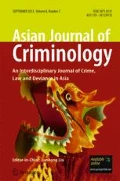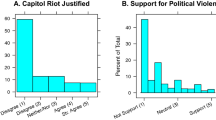Abstract
The Indonesian social system began to disintegrate in 1997. In the aftermath of social collapse, many forms of state crime, organized crime, terrorism, ethnic violence, religious violence, assassinations and other political violence escalated. An anomie theory interpretation is offered of this rise and the subsequent fall of a complex of serious crime problems. Security sector reintegration, reintegration of perpetrators and reconciliation (without truth) played important parts in enabling the rebuilding of institutions of security.

Similar content being viewed by others
Notes
By 2005, public opinion poll support for al Qaeda had also fallen dramatically from support by 58% of the population in 2002. During the second Gulf war, Saddam Hussein was the most popular name for babies born in Indonesia (Kivimäki 2007).
Negative peace means the absence of war in the Peacebuilding Compared project, while positive peace means a peace secured through commitment to the justice of the post-conflict institutional settlement [see Galtung (1969) for the original formulation]. And see in turn the foundations for this in the seventeenth century thought of the Dutch philosopher Spinoza: ‘Peace is not an absence of war, it is a virtue, a state of mind, a disposition for benevolence, confidence, justice’.
At the time of writing in 2009 there is concern that political support for tough corruption enforcement may be waning, with President Yudhoyono being publicly critical of sting operations against fellow politicians during the 2009 election campaign, for example.
Wilson’s (2008) research on North Maluku, as discussed in Braithwaite et al. (2010), highlights the role of youthful masculinities, the pursuit of excitement in the onset of that armed conflict. Just as a demography of a youth bulge can be important to sharp upward movements in rates of common crime, so our systematic empirical work over time may show that youth bulges are associated with increased risks of armed violence, including in some of these Indonesian cases.
Of course it would have been better had they been prevented from ever arriving in Christian areas as happened in 1999 when the first 300 of what was said to be a contingent of 800 Laskar Jihad were intercepted and sent back by police on their way to Manado in Christian Northern Sulawesi (source for this is an undated manuscript by David Henley, Mieke Schouten and Alex Ulaen entitled ‘Preserving the Peace in post-New Order Minahasa’).
Maria Ericson identifies three elements in securing reconciliation:
-
The establishment of safety, including bodily integrity, basic health needs, safe living conditions, financial security, mobility, a plan for self-protection, safe and reliable relationships, and social support.
-
Remembrance and mourning, telling the story of one’s trauma.
-
Reconnection with ordinary life (Maria Ericson, paraphrased in Daly and Sarkin (2007: 47).
On reflection, none of these require learning the truth of the root causes of the conflict.
-
Papua and West Kalimantan are the cases where least reconciliation has been secured.
The justice enforcement effects we have found also deepen rather than resolve the puzzles of truth, justice and reconciliation. North Maluku, like Bougainville in the second volume of Peacebuilding Compared, is a case where everyone involved in the conflict was amnestied, a condition for peace demanded by militia leaders. A contrast is Central Sulawesi where there were a considerable number of criminal prosecutions and even executions for war crimes, but where the feeling on both sides was that scapegoats rather than the major elite criminals of the conflict were put on trial. With the exception of thousands of arrests of GAM members in Aceh during that war (almost all amnestied in compliance with the Helsinki peace accord), impunity was overwhelmingly the justice norm across these conflicts and was mostly accepted by elites and ordinary people alike as part of the spirit of a non-truth and reconciliation that put the horror behind them and moved on.
References
Aspinall, E. (2005). Opposing Suharto: Compromise, resistance, and regime change in Indonesia. Stanford, CA: Stanford University Press.
Aspinall, E. (2009). Islam and Nation: Separatist rebellion in Aceh, Indonesia. Stanford, CA: Stanford University Press.
Barron, P., Kaiser, K., & Pradhan, M. (2004). Local conflict in Indonesia: Measuring incidence and identifying patterns. Jakarta: World Bank.
Bertrand, J. (2004). Nationalism and Ethnic Conflict in Indonesia. New York: Cambridge University Press.
Birchok, D.A. (2004). Channeling echoes: the collection and narration of Acehnese effective histories in America. Master's thesis, University of Michigan, Ann Arbor.
Bourchier, D. (1999). Skeletons, vigilantes and the armed forces fall from grace. In A. Budiman, B. Hatley, & D. Kingsbury (Eds.), Reformasi: Crisis and change in Indonesia. Melbourne: Monash Asia Institute.
Braithwaite, J, (2002). Restorative Justice and Responsive Regulation. New York: Oxford University Press.
Braithwaite, J. (2005). Between proportionality and impunity: confrontation-truth-prevention. Criminology, 43(2), 283–306.
Braithwaite, J., Cookson, M., Braithwaite, V., & Dunn L. (2010). Anomie and violence: Non-truth and reconciliation in Indonesian peacebuilding. Canberra: ANU E Press.
Braithwaite, V. (2009). Defiance in Taxation and Governance: Resisting and dismissing authority in a democracy. Cheltenham: Elgar.
Brehm, S. S., & Brehm, J. W. (1981). Psychological reactance: A theory of freedom and control. New York: Academic.
Chua, A. (2004). World on fire: How exporting free market democracy breeds ethnic hatred and global instability. New York: Anchor Books.
Cloward, R., & Ohlin, L. (1961). Delinquency and opportunity. Glencoe, IL: Free.
Cohen, S. (1972). Folk Devils and Moral Panics: The creation of the mods and rockers. St Albans: Paladin.
Collier, P., & Hoeffler, A. (2001). The Collier-Hoeffler model of civil war onset and the case study project research design. Policy Research Working Paper 2355. Washington, DC: World Bank.
Collier, P., Hoeffler, A., & Sambanis, N. (2005). Greed and grievance in civil war. In: P. Collier & N. Sambanis (Eds.), Understanding civil war: Evidence and analysis, volume 2: Europe, Central Asia and other regions. Washington, DC: World Bank.
Daly, E., & Sarkin, J. (2007). Reconciliation in divided societies: Finding common ground. Philadelphia: University of Pennsylvania Press.
De Toqueville, A. (1856). The old regime and the French revolution. New York: Doubleday. 1955.
Doyle, M.W. and Sambanis, N. (2006). Making War and Building Peace: United Nations peace operations. Princeton, NJ: Princeton University Press.
Durkheim, E, (1897 [1952]). Suicide: A study in sociology. London: Routledge & Kegan.
Esty, D., Goldstone, J., Gurr, T., Harff, B., Levy, M., Dalbeko, G., Surko, P. & Unger, A. (1998) State Failure Task Force Report: Phase II findings, July 1998.
Fearon, J.D. & Laitin, D.D. (2003) Ethnicity, insurgency, and civil war. American Political Science Review. 97(1), 75–90.
Galtung, J. (1969). Violence, peace and peace research. Journal of Peace Research 6(3), 167–191.
Geertz, C. (1983). Local knowledge: Fact and law in comparative perspective. In C. Geertz (Ed.), Local knowledge: Further essays in interpretive anthropology (pp. 167–234). NY: Basic Books.
Geneva Declaration. (2008). Global burden of armed conflict. Geneva: Geneva Declaration Secretariat.
Gurr, T.R. (2000). People Versus States: Minorities at risk in the new century. Washington, DC: United States Institute of Peace.
Hegre, H., Ellingsen, T., Gates, S., & Gleditsch, N. P. (2001). Toward a democratic civil peace? Democracy, political change and civil war, 1816–1992. American Political Science Review, 95, 33–48.
Hernawan, B.J. (2008). The Practice of Torture in Aceh and Papua, 1998–2007 with an Annex on the Situation of Human Rights in Timor Leste. Jakarta: SKP Jayapura.
Hill, H. (2007). The Indonesian economy: Growth, crisis and recovery. Singapore Economic Review, 52(2), 137–166.
Human Rights Watch. (2006). Too high a price: The human rights cost of the Indonesian military’s economic activities. London: Human Rights Watch.
Huntington, S. P. (1991). The third wave: Democratization in the late twentieth century. Norman and London: University of Oklahoma Press.
King, P. (2004). West Papua and Indonesia since Suharto: Independence, autonomy or chaos. Sydney: UNSW Press.
Kivimäki, T. (2007). Can development and democratization address the root causes of terrorism in Southeast Asia? The Pacific Review, 20, 49–73.
Lindsey, T., & Pausacker, H. (Eds.) (2005). The Chinese in Indonesia – Remembering, Distorting, Forgetting. Singapore: ISEAS Singapore and Monash Asia Institute.
Mancini, L. (2005). Horizontal inequality and communal violence; Evidence from Indonesian districts. Oxford: Centre for Research on Inequality, Human Security and Ethnicity.
Mansfield, E, D. & Snyder, J. (2007). Electing to Fight: Why emerging democracies go to war. Cambridge, MA: MIT Press.
Marshall, M.G., & Gurr, T.R. (2003). Peace and Conflict 2003: A global survey of armed conflicts, self-determination movements, and democracy. Center for International Development and Conflict Management, University of Maryland, College Park.
McLeod, R. (2003). After Soeharto: Prospects for reform and recovery in Indonesia. Canberra: Australian National University, Economics Department, RSPAS.
Merton, R.K. (1949) Social Theory and Social Structure. New York: Free.
Mietzner, M. (2003). Business as usual? The Indonesian armed forces and local politics in the post-Soeharto Era. In: E. Aspinall & G. Feeley (Eds.), Local power and politics in Indonesia: Decentralisation and democratisation. Singapore: IDEAS.
Parmentier, S., & Weitekamp, E. (Eds.). (2007). Crime and human rights (pp. 109–144). Amsterdam/Oxford: Elsevier .
Payne, L. A. (2008). Unsettling accounts: Neither truth nor reconciliation in confessions of state violence. Durham: Duke University Press.
Purdey, J. (2006). Anti-Chinese violence in Indonesia, 1996–1999. Singapore: Singapore University Press.
Rinakit, S. (2005). The Indonesian military after the new order. Singapore: NIAS.
Sidel, J. T. (2008). The manifold meanings of displacement: Explaining inter-religious violence, 1999–2001. In E.-L. E. Hedman (Ed.), Conflict, violence, and displacement in Indonesia. Ithaca: Cornell Southeast Asia Program.
UNDP. (2006). Tackling corruption, transforming lives: Accelerating human development in Asia and the Pacific. Delhi: UNDP and Macmillan India.
van Klinken, G. (2007). Communal Violence and Democratization in Indonesia: Small town wars. London: Routledge.
Varshney, A., Panggabean, R., & Tadjoeddin, M. (2004). Patterns of collective violence in Indonesia 1990–2003, UNSFIR Working Paper (04/03). Jakarta: United Nations Support Facility for Indonesian Recovery.
Wibowo, S.H. (2001). Growth convergence in Souteast Asia and the underground economy. PhD Dissertation, Southern Illionois University at Carbondale.
Zartman, I. W. (1985). Ripe for resolution: Conflict and intervention in Africa. Oxford: Oxford University Press.
Author information
Authors and Affiliations
Corresponding author
Rights and permissions
About this article
Cite this article
Braithwaite, J. Anomie and Violence in Indonesia and Timor-Leste, 1997–2009. Asian Criminology 6, 51–68 (2011). https://doi.org/10.1007/s11417-010-9087-2
Received:
Accepted:
Published:
Issue Date:
DOI: https://doi.org/10.1007/s11417-010-9087-2




